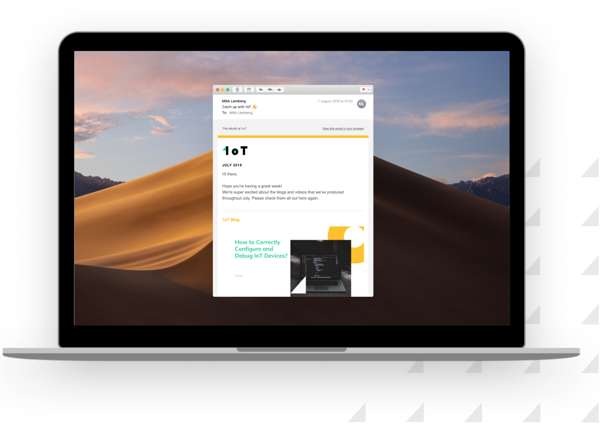Article was last updated on Jan 11th, 2022.
In the most recent post about the Mobile IoT technologies, we did a thorough comparison of NB-IoT and LTE-M standards and gave suggestions which one to choose for your IoT project.
This time I'll focus on the real-life deployment examples of several IoT applications that use dedicated Mobile IoT connectivity standards.
The topic is essential today as the IoT market matures. Everything from sensors and smart meters to asset trackers and digital locks can be connected to global IoT cellular networks.
This overview aims to show some existing deployment models, and be a conversation starter once you have started thinking about your use case.
The IoT applications that we're going to cover in this post are:
- Electric Bikes Tracking
- Home Appliances Monitoring
- Smoke and Gas Detectors
- Asset Tracking
Electric Bikes Tracking (NB-IoT)
NB-IoT can become the answer to challenges caused by the rapid expansion of shared electric bikes. City councils have faced many problems caused by the uncontrolled use of electric bikes. These include a high rate of theft, a high rate of traffic accidents, or a higher proportion of fire hazards.
Connecting electric bikes with NB-IoT enabled GPS modules allows us to collect near-real-time data, including the position and speed of the bike. NB-IoT has low power consumption; thus, it isn't affecting the bike's battery life. With extended coverage indoors and in hard-to-reach locations, this solution provides convenience for local councils and their citizens while also benefiting the police.
NB-IoT is well-positioned for the massive management of electric bikes. It can support a large number of connections and offers better coverage than standard cellular technologies. Despite being less suited for longer range mobility use cases than LTE-M, for example due to transitions between cell towers, the choice of technology for particular deployments is also driven by emerging regional trends (specific focus on NB-IoT in China) and mobile operators prioritising only one of Mobile IoT technologies.
From the security perspective, it uses a mutual authentication (as do the standard cellular technologies of 2G, 3G, 4G), as well as an encryption of user's data in transit over a cellular connection to a central system.
Finally, the connectivity is cost-effective with the low bandwidth allowing for low power consumption and the battery life cycle of up to 10 years.
Home Appliances Monitoring and Sharing (LTE-M / NB-IoT)
Home and business appliance vendors can improve maintenance services and make thoughtful decisions around improving the future design of the appliances by collecting device-related diagnostics and telemetry information from the entire lifecycle. By home appliances, we mean washing machines, dishwashers, fridges, ovens, boilers. And we can include business-oriented devices as well — things like printers, air conditioners, and water purifiers.
By implementing a central management platform, vendors can start managing the entire lifecycle of products, from manufacturing, logistics, and warehouse to retailing and maintenance. Having a controlled ecosystem with operational data opens up the possibility to offer several value-added services. For example, fault alerts notifications, providing preventive repair service or proactive diagnostics checks. Also, monitoring devices opens new possibilities for subscription services, including on-demand delivery of necessary consumables like detergents, filters, or other related products.
Using NB-IoT or LTE-M, rather than the implementation of Wi-Fi for these scenarios, has several advantages. The main one being a lack of manual configuration step required for connection to a local Wi-Fi router, with Mobile IoT technologies connecting automatically to a cellular network, and the connection being activated already at the time of appliance's production in the factory.
Other advantages are the reliability and security of cellular networks. Compared to unexpected disconnection of Wi-Fi because of password changes, changes in a router configuration, limits on too many simultaneous connections in a household, or the security risk of hacking a router access password leading to unsecure connections. Additionally, such use cases don't need the high-speed connectivity offered by Wi-Fi.
Both NB-IoT and LTE-M are deployed in a licensed range and use the mobile operator's purpose-built private VPN tunnel leading straight to the manufacturer's data centre.
Furthermore, a coverage extension feature means the device and the network can repeat the message multiple times to improve the success rate of connectivity. Equally important is also the fact that almost all home appliances operate indoor, often in basements or hard to reach areas. Mobile IoT technologies are designed to provide coverage deep indoors.
Finally, NB-IoT or LTE-M modules have a much smaller form factor than conventional cellular modules, making it easier to accommodate in the appliance design and reduce their pricing footprint.
The constant connectivity and the cost-efficiency of NB-IoT modules enable appliance manufacturers to explore new business opportunities, such as the deployment of an industrial type of machinery that can be rented on a per-use basis, with a laundry self-service being one of the examples.
Here, the entire user experience is centered around a mobile app connecting to a backend service, firstly allowing for registration to the service, then making the laundry service reservation and advanced online payment, followed up by the remote monitoring of the laundry cycle progress, and finally, after the washing is completed automatically notifying the end-user.
Smoke and Gas Detectors (NB-IoT)
Many businesses from the hospitality sector, like hotels, restaurants, and rented properties are increasingly looking to use specialised detection equipment to minimise losses and damages caused by fires and toxic gases.
Detectors connected to a monitoring backend platform, besides detecting gas leaks or smoke, are also able to alert people in the affected area of the building. Or activate necessary protective measures, send alarms to emergency services and the building facility management with more detailed information about the incident.
For densely populated areas or in the buildings that are not suitable for a LAN connection cabling of detectors, cellular connectivity becomes the solution.
Specifically, NB-IoT technology allows for extended coverage, including in ceilings, basements, closets or other hard to reach places, and for a long lifetime of backup power batteries.
Additionally, NB-IoT devices are fully capable of communicating with a backend system at regular intervals allowing for a 'heartbeat' type messaging with up to date data measurements, for example, including information on current levels of carbon monoxide and smoke.
Asset Tracking (LTE-M / NB-IoT)
Tracking locations of high-value assets, such as shipping containers, trailers, rail wagons, and large machinery, allow businesses such as freight logistics and construction companies to gain new data insights into their supply chains (avoiding the potential loss of assets and cargo, or retrieving those that go missing). It is making way for cost reductions, an increase in operational efficiency, and ultimately a better customer experience.
Utilising existing and the sometimes still patchy coverage of Mobile IoT technologies allows for reporting only when an asset tracker gets in range of either NB-IoT or LTE-M. When in transit and moving from one cell tower to another, the tracker could report its location on a more frequent basis, effectively enabling tracking in near real-time. On the other hand, it can report less frequently when in a stationary position or lacking network coverage.
When it comes to moving devices, LTE-M is situated as being much better suited for mobility as it manages a smooth handover between cell towers without dropping the connection, whereas a NB-IoT connection joins a single base station and has to reestablish a new connection each time it reaches a new network cell.
The asset tracker device itself can be equipped with additional modules expanding its capabilities, such as a GPS module to allow reporting more accurate location coordinates, or an external power source like a solar panel as an independent source of battery charging, or any other sensors measuring temperature, pressure, or door lock position.
The complete solution also allows for the customer access to the location and telemetry data via APIs or a web portal.
Compared with traditionally used tracking mechanisms such as RFID tags that are popular among low-value assets, and do not support actual location updates (but register check-in and check-out events), Mobile IoT technologies with their lower price for module devices and costs of transported data, as well as increases in battery lifetime, can lead to better adoptions also in low-value assets tracking, like parcels, bags, or suitcases.
Conclusion
There are two alternatives, and at the same time, complementary choices for Mobile IoT connectivity focused on the coverage of large areas at a low cost and with low device complexity. As presented in the examples, both technologies are almost equally suitable to support different sectors in the IoT enterprise and consumer markets.
Usually, the choice of a particular technology is based on their availability and support in a given region and targeted area of implementation.
Moreover, NB-IoT and LTE-M are set to become an integral part of mobile operators' 5G proposition for IoT applications. That ensures that they are future-proof and will continue to support applications requiring this type of connectivity.
1oT is already offering connectivity services for industrial IoT use cases, with the support from our carrier partners and in a wide range of cellular technologies, including NB-IoT and LTE-M, and standard 2/3/4G technologies. We have also designed a connectivity management platform (CMP) specifically for IoT devices, so read more to learn what makes our CMP special.
We hope you found this mini-series of blog posts helpful and educational. If there are any further questions or are considering getting into the Mobile IoT connectivity, do not hesitate to contact us directly at hacking [at] 1oT.com.









